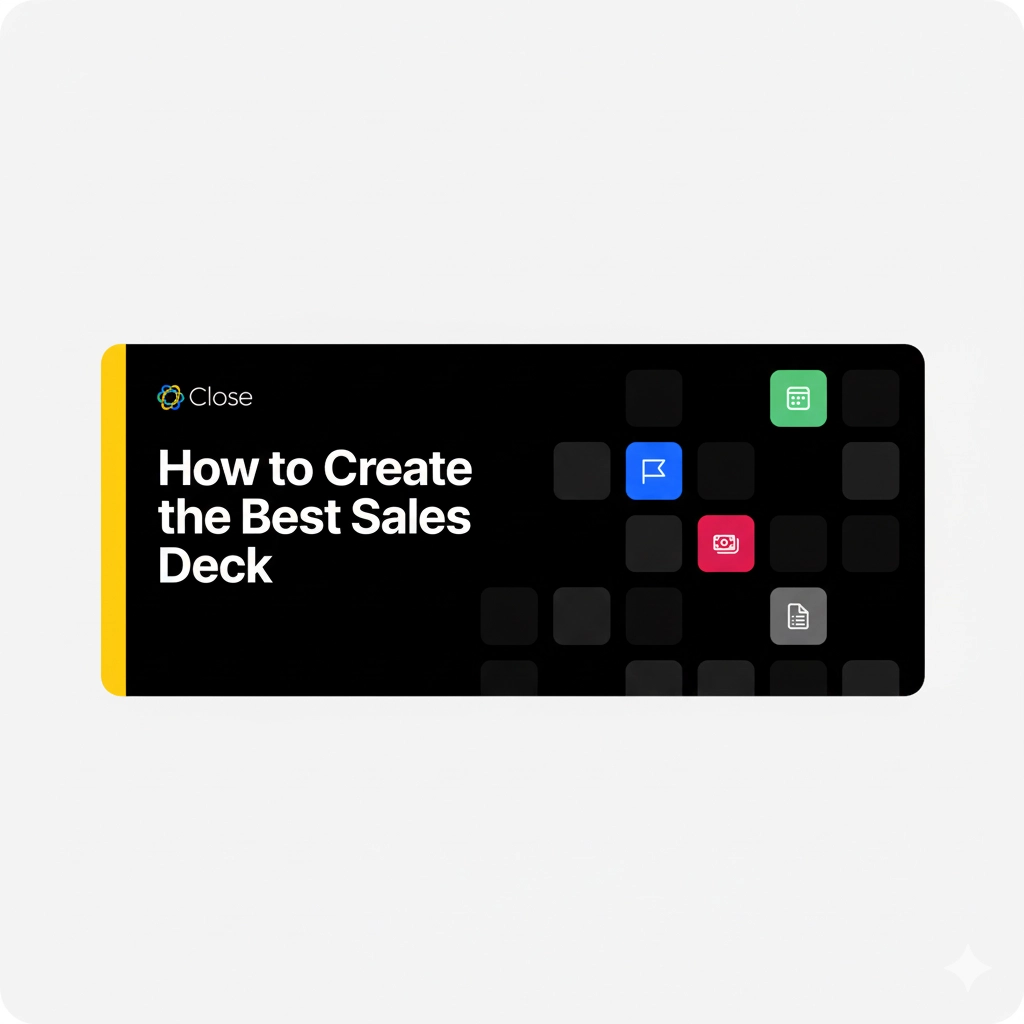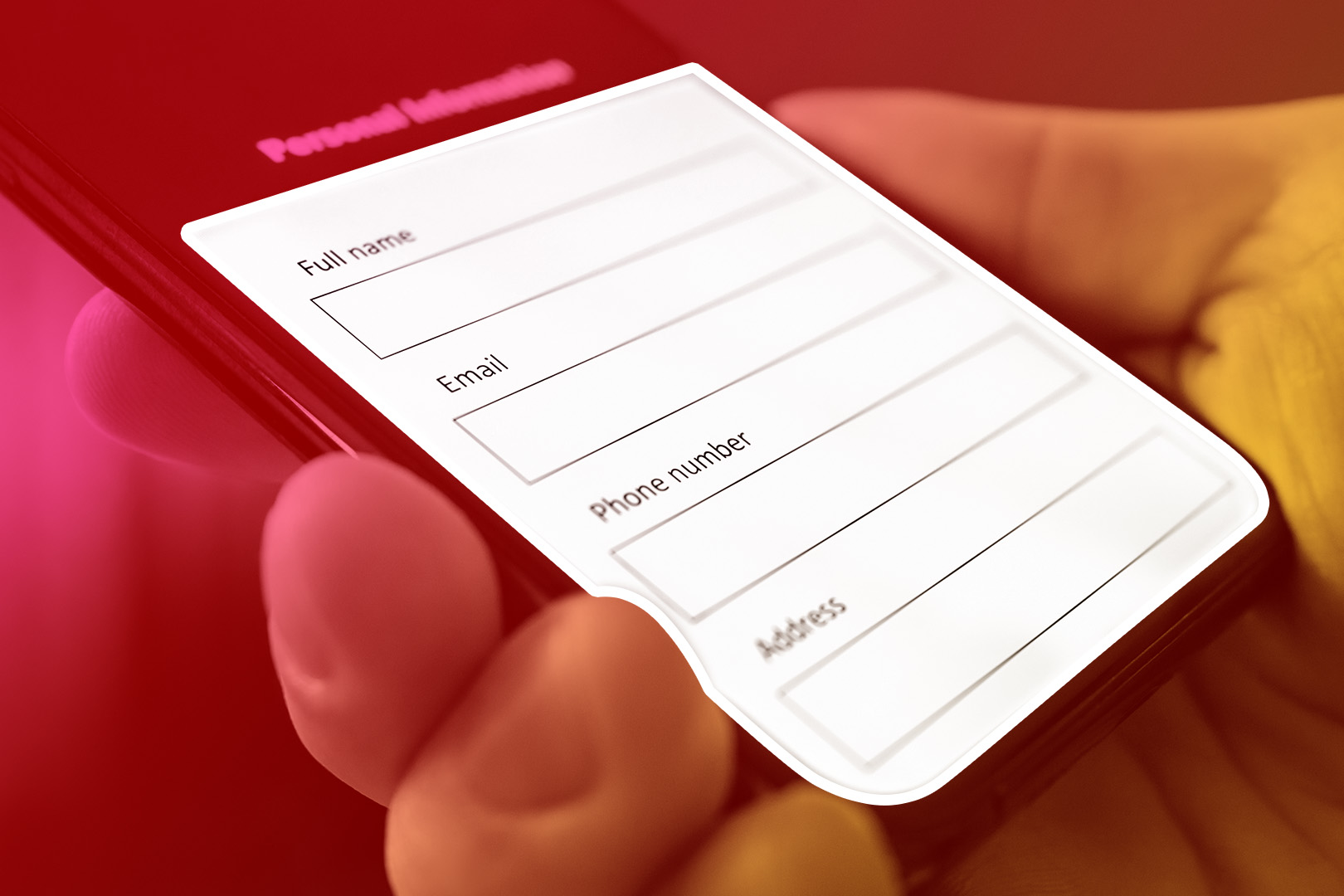You’ve been working hard to sell this prospect. You’ve moved them down the pipeline, and now it’s time to clinch the deal with a sales pitch deck that blows their mind.
You’re going into that sales meeting. The bases are loaded. Are you prepared to hit a home run?
The best sales pitch deck is a tool that knocks your sales presentations out of the park every time. But how can you create a sales pitch deck that sells?
Keep reading.
What is a Sales Pitch Deck? (+ When & Why Do You Need One?)
A sales pitch deck is a presentation that salespeople in various industries use to answer two essential questions for their prospects:
- What are we offering?
- Why should our leads care?
When done correctly, your sales pitch deck can help prospects see the real value of your product and convince them of the ROI of the purchase. It’s a gateway to a productive sales conversation that leads to a closed deal.
It's important to note the differences between a pitch deck and a sales deck:
A sales deck, as we just described, is a presentation designed to convince prospects to make purchases. On the other hand, a pitch deck is typically shown to investors. The goal? To convince them to support a company with additional funds.
(Note: we share a few sales deck examples in a later section of this article. Stay tuned!)
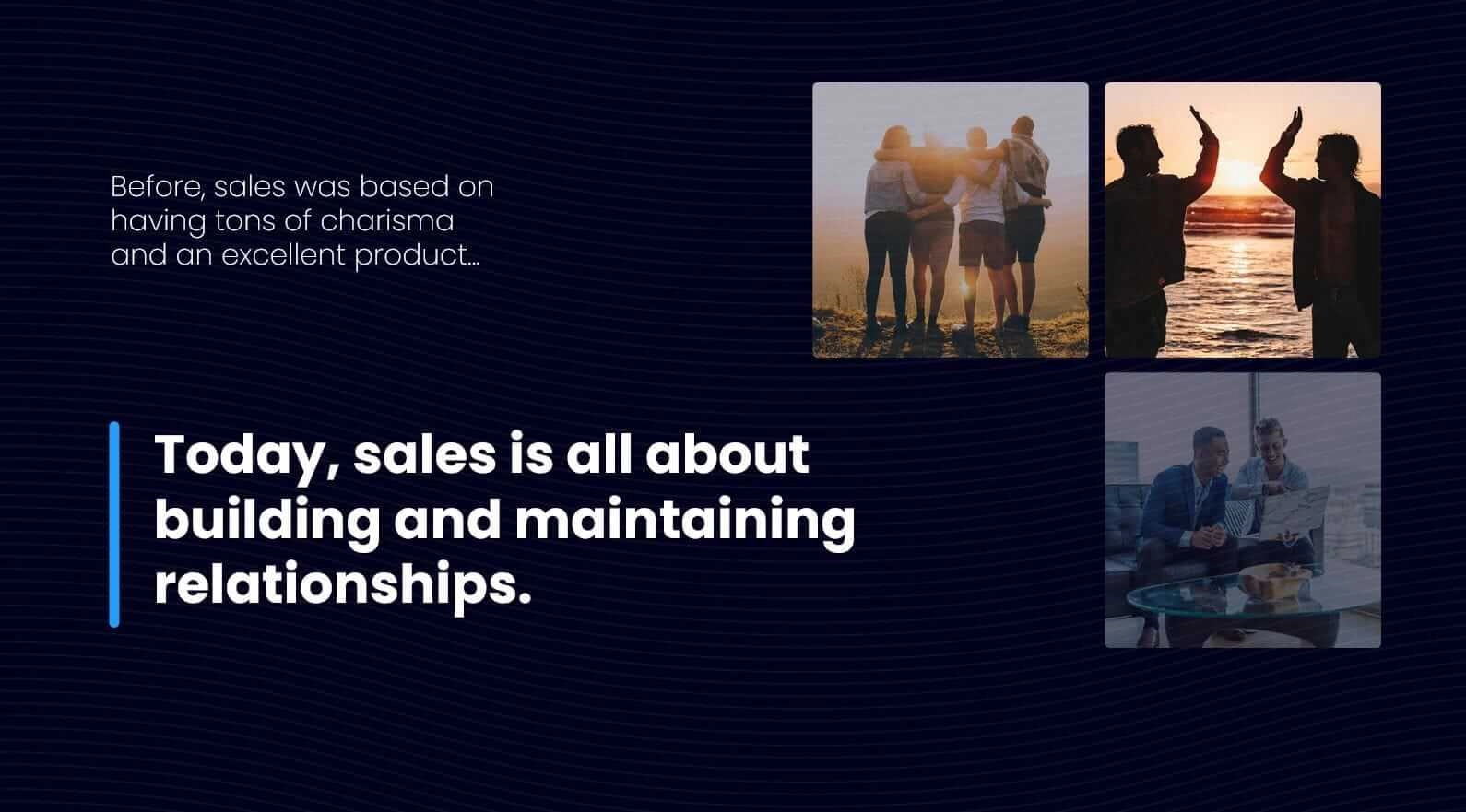
So, when can you use a sales pitch deck?
There are plenty of different situations where a deck can amplify your message and bring context to your product's value.
You can use sales pitch decks at almost any stage of your sales pipeline, like:
- Prospecting and lead generation: At the early stages, a simple presentation that sparks curiosity can arouse the interest of new leads. For example, you can post a short, concise presentation on social media.
- Discovery and qualification: A sales deck can help you guide the conversation and add more meaning to your statements in a discovery meeting.
- Sales meetings: At this stage, a sales pitch deck should present features and benefits that will impact your prospect most, convincing them to move towards a close. Because of this, many sales reps use case studies at this stage.
Decks are also essential to a startup investor pitch, and can even be created as an internal sales enablement presentation to help keep your sales messaging on track across the team.
Creating these different types of sales pitch decks will empower your sales team to reach their potential and tailor their sales strategy to each situation.
So, what does it take to build a high-performing sales deck? Learn how to do it in 6 easy steps:
Creating a Sales Pitch Deck in 6 Easy Steps
Every effective sales strategy needs a rock-solid sales pitch deck. Building your deck from the ground up? Here are 6 steps to help you build the best one ever.
Step 1: Use Real Customer Research to Find a Key Pain Point
When you know who you’re selling to, you can tailor your pitch to their needs and circumstances, from the first slide to the last.
That’s why you must do customer research before you start building your sales pitch deck.
Who are your customers? What kind of businesses do they run? What team does your main point of contact work on? What are the team or the company’s main challenges? Which competitors are they considering? How does your product integrate with their current workflow?
To answer these questions, run customer interviews or send out a quick survey to your most successful customers. Here’s an example of what that might look like from SurveyMonkey:
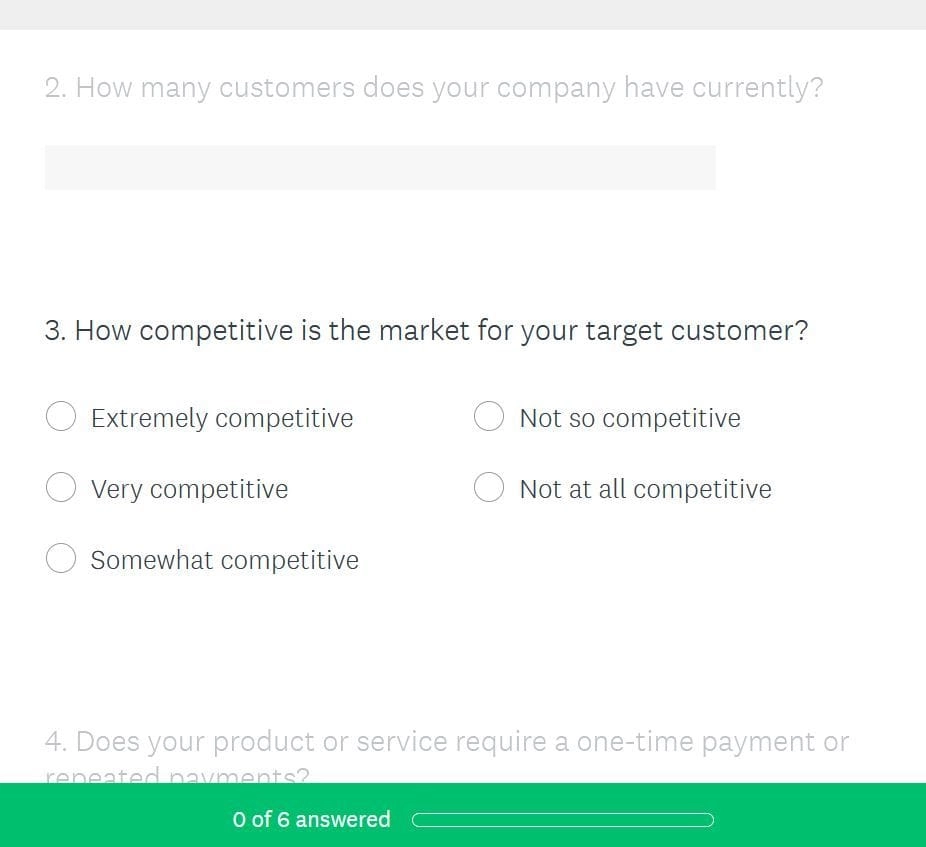
The more intimate knowledge you have of your customers, the better prepared you'll be to develop a sales pitch deck that resonates with your target audience.
Specifically, try to get constructive answers to these two questions:
- What are their main needs/wants/challenges?
- How does your product solve those needs?
Step 2: Develop a Narrative Around Your Product
Now that you understand the problems your audience is facing, it’s time to build a narrative around that problem.
In most cases, a sales pitch deck will start with slides that focus on the problem and provide a solution.
So, what’s the story of your product?
Your customer research is a great place to start with this narrative. What was life like before they started using your product? What were the day-to-day challenges that just couldn’t be solved? Was there a shift in the industry that caused new issues for businesses?
Then, paint a picture of the solution. What could life be like after solving these issues? How would the prospect’s day-to-day work life be affected? How would the team or company benefit?
After that, your story introduces its hero: your product.
By creating a narrative that explains the problems your prospects are facing better than they can, you’ll prove your deep understanding of their needs. This builds trust and lays the groundwork for a relationship that will last.
Step 3: Decide on 3 Key Benefits to Highlight
Three is a powerful number.
Of course, your offerings may include an entire tool shed of amazing product features, which your customers will be able to use to improve their lives and businesses. But remember: your sales pitch deck isn’t here to teach them the A to Z of your product.
It’s here to make an impression and convince them to move forward in the sales process.
That’s why choosing 3 main benefits is essential.
As Brian Clark of Copyblogger said:

To help you narrow this down, pick the three features that your customers regularly rave about. Then turn those features into benefits and add them to your presentation.
Pro Tip: Want to really cement these three benefits into the prospect’s mind? Don’t just include them as a slide in your sales deck; use them as a quick summary at the end of your presentation to keep them top-of-mind.
Step 4: Choose Your Most Powerful Proof
Everyone loves using social proof. It’s spattered across SaaS homepages, wandering across our daily blog reading, and practically taking over our Instagram feeds.
In other words, what was once a powerful tool for trust has become a bunch of background noise to your customers.
So, how can you include social proof that stands out and makes a clear point?
The best sales pitch deck uses social proof that is relatable.
For example, if you’re pitching to a small business owner, featuring a customer quote from P&G may actually turn them off. While it’s cool that you have P&G as a customer, they’re instantly doubting whether your product is ideal for a small business like theirs.
So, if you’re pitching to a startup founder, feature a use case and testimonial from another startup founder. If you’re pitching to a restaurant owner, feature a quote from another restaurant owner who really loves your product.
SEO software Ahrefs does a fantastic job of this on the product homepage, featuring different testimonials divided by the type of customer:

Whenever possible, feature social proof from customers that are part of your prospect’s tribe. They’ll automatically feel better understood and more confident about your product for their company. This is one of the keys to creating a winning sales deck.
Step 5: Use a Sales Pitch Deck Template That’s Tailored to You
No, it’s not cheating.
An effective sales pitch deck template is a great way to get a head start on your deck and make it truly appealing to your prospects.
But just remember these two essential keys to achieve success:
- First, personalize the template as much as possible. Any self-respecting sales pitch deck template should be customizable. So change the fonts and colors and replace any stock pictures with your own. Otherwise, your prospects might notice that your sales pitch deck is awfully similar to the competition’s deck.
- Second, use an industry-specific template. How you present your product as a B2B company may be completely different from how a SaaS company pitches. Also, different types of sales pitch decks work better for different situations. Make sure you use the right one at the right time.
Step 6: Make it Visually Relevant to Their Brand
This last step can turn your sales pitch deck into something even more desirable...
Your customers have probably seen decks with their logo in the corner. Want to make your sales pitch deck stand out? Build it in the colors of the brand you’re selling to.
This frames your message as if it’s coming from the inside, not from an external source. And, it helps you present the message in the voice of your customer.
With the sales pitch deck templates we mentioned above, it’s super easy to adjust the colors. (We even include simple instructions within the decks to help you customize them to your style and needs!)
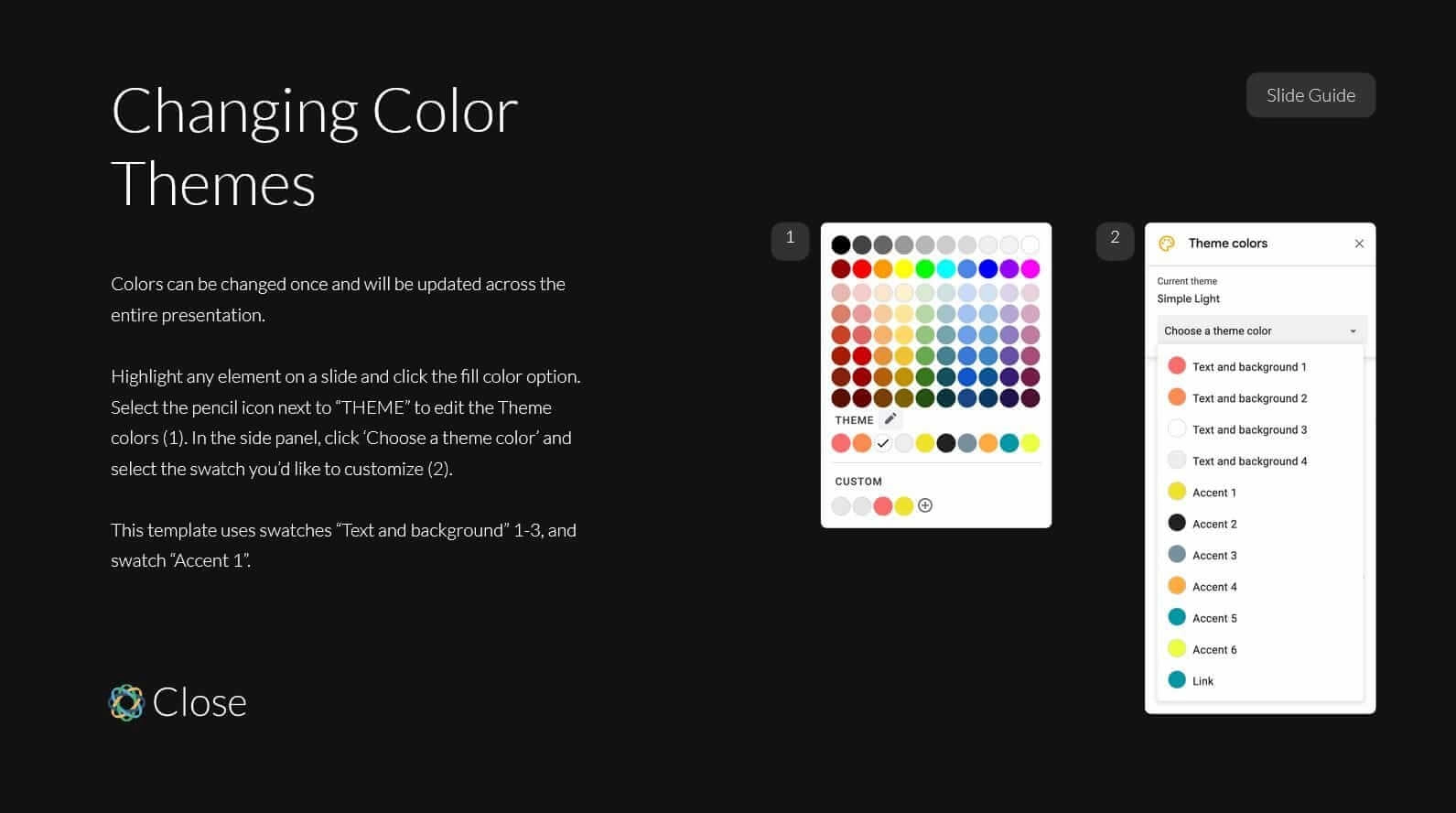
While we're talking visual design, we should say: make proper use of white space, don't load up your slides with tons of text, and use bullet points when appropriate.
The way you present information is just as important as the information you present. If your sales pitch deck is hard to read, you won't grab your audience's attention. So, do your best to simplify the viewing experience for your prospects.
Bringing it All Together…
Now that we've given you six steps to create a killer sales pitch deck, let's take a quick moment to outline the elements every deck should have:
- A brief explanation of your company
- A statement of the problem your product solves
- Why your solution is better than the competition's solution
- Social proof in the form of testimonials and/or case studies
- A call to action (CTA) that tells prospects what to do after your deck ends
- An appendix that gives and/or refers prospects to more information
Most successful sales decks include each of these six elements. Speaking of, want to see a few real-world examples of stellar decks? Let's take a look!
6 Sales Pitch Deck Examples to Model Your Pitches After
Sometimes, the best way to learn is to check out a few examples.
See what top B2B and SaaS companies are doing with their sales pitch decks and the key elements they incorporate. Then swipe the best ideas for your next sales presentation, delivered via PowerPoint, Keynote, or whatever other platform you use:
1. Shift in the Market from Zuora
Zuora Sales Deck from Ryan Gum
Industry Focus: B2B
In this deck, Zuora highlights a drastic shift in the market, shows the impact for companies who adapt, and then uses real customer testimonials to show why their product is the solution. By telling a story, this deck captures and holds attention.
2. Finding Waldo with LeadCrunchAI
LeadCrunch.ai Sales Deck from LeadCrunch
Industry Focus: SaaS
Again, storytelling is essential here. This deck presentation also starts by describing a market change and leans into the opportunities available. Then, in 6 simple slides, it explains a complicated product in simple terms, while the use of Waldo, a beloved literary character we all remember from grade school, makes it uber-relatable.
3. Problem, Solution from ReCheck
ReCheck Docs Sales Deck from recheck
Industry Focus: SaaS
This deck doesn't mince words: it gets right into the meat by explaining the problem and providing a clear solution. For a simple product, this kind of simple sales deck is perfect.
4. Proof in the Data from Snapchat
Snapchat Advertising Sales Deck from Ryan Gum
Industry Focus: B2B
Snapchat shows the power of its ads with this easy-to-digest deck. It includes powerful graphs and metrics, bright colors, and excellent testimonials.
5. Totally Relatable from ProdPad
ProdPad Sales Deck - Software for Highly Effective Product Managers from ProdPad
Industry Focus: B2B
This deck gets the prospect to say, "Wow, that's me!" By telling a story the prospect can relate to, this deck does an excellent job of getting on the same side as the prospect and showing them what's possible if they use the ProdPad product.
6. In the Mind of the Prospect With Immediately
Immediately Sales Deck from Lilly Skolnik
Industry Focus: B2B
Instead of using hard data to prove the value of their product, Immediately takes that data and turns it into the thoughts of their audience (sales reps). This adds a bit of humor to their very relatable deck, and shows the real-world impact their product can have for any rep that uses Google, Outlook, and/or Salesforce.
9 Pro Sales Pitch Presentation Tips
Now your best sales pitch deck is ready to unleash its power on your prospect. But how can you present your deck successfully? Here are nine pro tips you need to follow:
1. Create Conversation
Your sales pitch deck isn’t here to replace the conversation. It’s here to help guide the conversation and add context and meaning to what you’re saying.
So, use your presentation as a conversation, not a monologue.
While you will probably do most of the talking in this meeting, remember to ask questions throughout. Build context around your value points by talking about the specific pains your prospects face, then digging into the ways your product solves them.
By asking questions, you can keep your prospects engaged throughout the presentation. This is especially important when you’re giving a remote sales presentation since it’s easier for the prospect to be distracted.
Pro Tip: Your body language is important when giving a sales presentation—even if you have a great sales deck to back you up. Work hard to make eye contact with your prospects and assume a confident posture to put your audience at ease.
2. Send Your Sales Pitch Deck Before the Meeting
But wait, doesn’t that defeat the purpose of actually giving your sales presentation?
Not necessarily.
In fact, sending your sales pitch deck before you go into your meeting can accomplish a few different things. For example, it can:
- Whet the appetite of your audience by giving them a sample of what you’ll discuss in your meeting (but saving the best parts for your actual meeting)
- Give your prospect the ability to see what topics you'll cover during the presentation, and prepare any questions they might want to ask
- Help everyone understand the agenda for this meeting and keep it in mind
So, while it may seem a bit backward, sending your presentation beforehand can actually help your prospects stay focused and keep your sales meeting on-schedule.
3. Create a Deck for Stakeholders to Read Later
While it’s true that it’s best to sell to decision-makers, that’s not always the first person you talk to at a company. Especially when selling to enterprise companies. Getting all the stakeholders and decision-makers involved in your sales pitch meeting is hard.
So, create a sales pitch deck that stakeholders and decision-makers can check out later. This deck may include more text than a deck you’re presenting in-person (or online) since the goal is for stakeholders to read it on their own and understand it easily.
Also, if an internal champion is presenting this information to higher-ups, they can use this deck to present ideas succinctly and with the right messaging.
4. Adapt Your Script and Presentation to the Prospect
According to Forrester, 77 percent of salespeople do not understand their prospects' issues. If you don't know your audience, you'll have a hard time selling to them.
Take time to study your prospects before you meet with them. Learn about their industry, the specific business they work for, and the potential problems they deal with on a daily basis. (LinkedIn can be a gold mine for this kind of information.)
Then take what you learn and use it to personalize your slide presentation. Doing so will help you connect with prospects on a deeper level and increase your sales.
5. Open with Your Biggest Selling Point Instead of Saving it for the End
If you were to write a book, or a movie, or a fictional story of any kind, you'd probably save your best scene for last, right? End with a bang, as the saying goes.
Guess what: you're not an author or a screenwriter. You're in sales. As such, open your sales deck presentation with your biggest value proposition. Lead with the most impressive stats. Share a particularly powerful testimonial or case study.
Hit your prospect hard and fast.
If you can dazzle the audience of your sales deck from the get-go, you'll keep them engaged the whole way through. It's pretty much guaranteed. So don't wait.
6. Ask Open-Ended Questions
Just because you're the one giving a sales presentation doesn't mean you have to talk the entire time. By asking your prospects questions, you'll better understand their needs. You can then personalize your approach to keep them engaged.
Just remember to ask open-ended questions, i.e., questions that your prospects can't answer with a simple yes or no. Here are a few you can use:
- Can you walk me through how your team handles [problem]?
- Have you found any workarounds for when [issue] happens?
- What would your ideal solution to this problem look like?
- How would you expect a solution to this problem to affect your team?
7. Build Context Around Your Biggest Selling Points and Value Differentiators
Which statement is more powerful:
"We help sales teams be more productive," or "We help sales teams cut back on data entry tasks, so they can boost productivity and spend more time closing deals."
The second one, right? The reason is that the second statement builds context. Being more productive is great. Being more productive, while minimizing data entry tasks (which all sales reps hate) and closing more deals is a game changer.
Don't just tell your prospects what your products and/or services can do in your sales pitch decks. Tell them how these things are done and why they matter.
8. Never Talk Price Before Value
This is one of the golden rules of sales—with good reason.
If you dive into the price of your products before you discuss the value they create, you turn them into commodities. People don't spend top dollar on commodities.
But what if prospects push for pricing information at the beginning of your sales presentation? Simple: push back. If they push harder, turn the question around and ask them something like, "Before we talk about the price, let me ask you: How much will it cost your company if you don’t get these issues solved by next quarter?”
Your sales decks will be more effective when value is established before price. Always.
9. Spend Less Than 10 Minutes Presenting
Have you ever watched an Apple product launch event? Every presenter speaks for less than 10 minutes. Why? Because audiences get bored with longer presentations.
The same goes for your sales pitch decks. If they take 20, 30, or (God forbid!) 60 minutes to get through, most of your prospects will check out before the end.
The goal of your sales deck should be to connect with potential customers; not to explain your products in excruciating detail. Ain't nobody got time for that.
Build Your Best Sales Pitch Deck
Giving a sales presentation may get your heart pumping. But when you have the best sales deck at your disposal—one that’s high-powered and follows a proven formula—you’ll be well-equipped to knock your presentation out of the park.
Throughout this guide, we’ve given you clear examples and free templates to learn from and imitate. That way you can build your own sales deck and crush the competition.
But we aren't done yet! Want more slide deck tips and expert sales advice? Check out our article on undeniably good sales pitch examples to close deals fast.
And, as always, we can offer you our assistance when it comes to baller CRM software, too. Our solution is used by tons of high-growth companies because it works. End of story. You already have to create amazing sales pitch decks. Don't complicate the sales process even more by using lame-duck tools. Try Close instead, free for 14 days.





